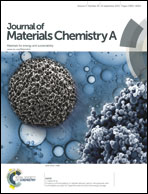High capacity and rate capability of a layered Li2RuO3 cathode utilized in hybrid Na+/Li+ batteries†
Abstract
A novel hybrid Na+/Li+ battery is established by using Li2RuO3 as the cathode, 1 M NaClO4 in 1 : 1 EC/PC solution as the electrolyte and metallic sodium as the anode. In the working voltages between 2.0 and 4.0 V, Li2RuO3 delivers a high discharge capacity of 168 mA h g−1 under the current density of 0.1 A g−1 and an excellent capacity retention of about 88.1% after 50 cycles. The cathode also exhibits superior rate capability and long-term cycle life, whose discharge capacity reaches 85 mA h g−1 after 300 cycles at the current density of 1 A g−1. Importantly, both Na+ and Li+ can reversibly intercalate/deintercalate into Li2RuO3 in the same manner as in the typical Li-ion half cell. In addition, ex situ X-ray diffraction patterns of the initial charge and discharge processes as well as after long electrochemical cycles are examined to study its structural evolution. Our studies provide a strong insight into the design and application of novel rechargeable batteries.


 Please wait while we load your content...
Please wait while we load your content...